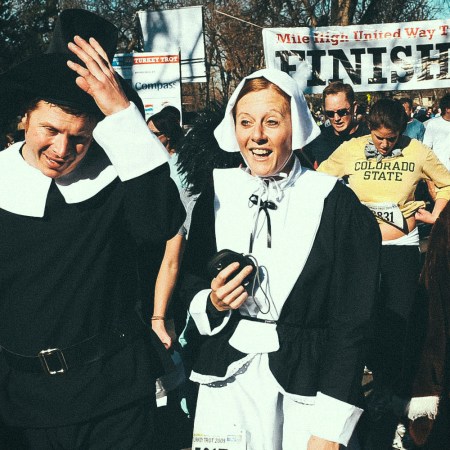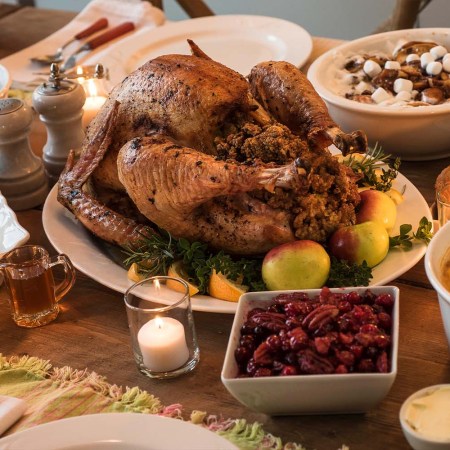A beloved Thanksgiving tradition that can trace its roots all the way back to Plymouth Rock, the breaking of the wishbone is meant to impart good luck on the victor for the entirety of the following year.
For the unanointed, it involves two participants who, after the wishbone has been retrieved from the turkey carcass and left to dry out for a set period of time, each grab a side of the bone. After both parties have made a wish, they then yank the bone apart; whoever ends up with the biggest portion of the bone is the winner. While debatably barbaric by today’s standards, the tradition remains a mainstay in most American households on the most quintessential of American holidays.
But as fate would have it, the wishbone predates the arrival of the earliest American settlers — in fact, there is very little “American” about the wishbone tradition at all … and it definitely didn’t originate with a turkey.
An ancient people hailing from Etruria, Italy, the Etruscans were considered a major Mediterranean trading power between the 8th and 3rd century BCE. They were a polytheistic people who recognized “gods for all those important places, objects, ideas, and events, which were thought to affect or control everyday life,” according to the World History Encyclopedia. They also considered birds to be creatures of the divine variety, even practicing alectryomancy, or “an ancient form of divination using a rooster to select grains of food placed on letters of the alphabet,” to predict the future, according to Folklore Thursday.
The Etruscans are the first to be credited with harvesting the furcula — aka the wishbone — but rather than breaking it after leaving it in the sun for a few days to dry, they would gently stroke it while making their wishes. It is said that the breaking of the wishbone, and subsequent competitive component, didn’t come into play until much later, after the tradition was absorbed by the Romans, due in large part to the scarcity of chickens. The idea was that, by breaking the bone in half, more people would have an opportunity to make a wish.
According to Peter Tate’s Flights of Fancy: Birds in Myth, Legend, and Superstition, after the Romans commandeered the practice, the breaking of the wishbone then descended into mainstream holiday customs, next making a pitstop in Medieval Europe … via a goose. Because the goose was revered as an object of worship, its consumption was limited almost exclusively to special occasions like St. Martin’s Day, a holiday originating in France that celebrates the end of the agrarian year and the beginning of the harvest.
“Geese were also eaten on St. Martin’s Night (11 November), an occasion on which the ‘divination of the wishbone’ or ‘merry thought’ took place: two people would pull the wishbone (in technical terms, the furcula) of the goose, and the person who broke off the larger piece could either make a wish or have the guarantee of good luck,” Tate wrote.
The parallels between St. Martin’s Day and Thanksgiving — fall; harvest; gratitude — are obvious, and it’s easy to see how, through the eyes of the first American settlers, the wishbone tradition seemed an obvious fit.
That said, a few other theories hold that the wishbone was actually kind of a sex thing, too. In an exploration of old English literature that lends itself nicely to the theory, Slate quotes the 1908 volume New English Dictionary, which then defined merrythought as “The name, like the synonym wish-bone, [which] alludes to the playful custom of two persons pulling the furcula of a fowl until it breaks; according to the popular notion, the one who gets the longer (in some districts, shorter) piece will either be married sooner than the other, or will gain the fulfillment of any wish he may form at the moment.” Per Folklore Thursday, some claim the wishbone is divine not because it hails from the insides of a divine creature, but because the bone “resembles the human crotch or female genitals, revered as the giver of all life.”
Similarly, in his 1600s folklore compilation, Remaines of Gentilisme and Judaisme, English polymath John Aubrey wrote, “Tis common for two to breake the Merrythought of a chicken-hen, or wood-cock, &c., the Anatomists call it the Clavicula; ’tis called the merrythought, because when the fowle is opened, dissected, or carv’d, it resembles the pudenda of a woman.”
All of this to say: it’s a bit of an odd tradition to be associated with arguably the most American of holidays, being that it originated in an ancient Italian civilization and is also, maybe, about sex. (Pilgrims, in case you’ve missed it, were famously puritanical.) Something to mull over while you break bread with far-flung relatives and partake in all other manner of festivities this Thanksgiving — the breaking of the pudenda-shaped furcula chief among them.
This article was featured in the InsideHook newsletter. Sign up now.






















